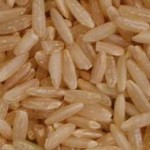Rice bran, which is the outer layer of the whole rice grain, is the part which is normally removed and thrown away. What most of us eat is the endosperm part of the rice grain which is mostly starch.
Let’s look at what nutrients gets thrown out when we remove the bran layer of rice – vitamins B1, B3, B6, manganese, iodine, some amount of protein (particularly lysine, an essential amino acid) and essential fatty acids. Bioactive phytochemicals like dietary fibre, phytosterols, and other phenolic compounds are also present in rice bran. 100 g of rice bran can meet a quarter of the needs of vitamins needed for our body. 
Researchers have found hundreds of metabolites in rice bran which have potential medicinal and health promoting attributes. While more research is needed to confirm this, what we already know about rice bran should convince us to eat unpolished rice in place of white rice.
Soon after I wrote a piece last week on Manipuris’ rice eating habits, a reader sent me an email on rice, titled “Rice was never meant for human consumption”. It went on to say how cavemen ate everything raw (fruits, veggies, nuts, meat), that they did not eat rice, wheat and other grains because they didn’t cook, that rice converts into sugar, white rice has no fiber, one can overeat rice but not fruits & veggies, rice is difficult to digest, and so on and so forth.
Some of the information in this email is true but not all of it. So, here’s busting the myths on rice and stating facts nutritionally –
- Rice is meant for human consumption but not compulsory in everyone’s diet.
- There’s a huge difference between a caveman and a modern day town dweller. If we need to follow the caveman’s food habits, we also need to follow the rest of their lifestyle!
- Rice, like all other carbohydrates, ultimately gets broken down into glucose. There’s nothing wrong with this biochemical cycle since glucose is needed for our daily energy.
- White rice has very little fiber but brown rice has more fiber and also more vitamins.
- Rice is not difficult to digest. Enzymes secreted in the human digestive tract are capable of digesting rice as well as other food groups.
- It’s good to reduce the intake of starchy items like rice, wheat, etc, and increase the intake of fruits, vegetables, sprouts, etc, especially if you’re watching your weight.
The bottom line is rice is not harmful when eaten the right way and in the right amounts. 
 During a recent visit to Coimbatore for a lecture, I met 2 students who belong to a tribe in Manipur. An interesting discussion on their food habits followed. Their staple is rice. They also eat fish everyday. Their diet includes lots of greens which are not commonly grown in other parts of India. Other vegetables, fruits and meat form a part of their regular meals. They do not take much dairy foods, but eat fermented fish, soy and bamboo shoots. The students said that although they enjoy the south Indian meals, on weekends they prepare some of their traditional dishes. Here’s the best part – they eat rice regularly but they are not fat! My cliched statement – Rice is not fattening!
During a recent visit to Coimbatore for a lecture, I met 2 students who belong to a tribe in Manipur. An interesting discussion on their food habits followed. Their staple is rice. They also eat fish everyday. Their diet includes lots of greens which are not commonly grown in other parts of India. Other vegetables, fruits and meat form a part of their regular meals. They do not take much dairy foods, but eat fermented fish, soy and bamboo shoots. The students said that although they enjoy the south Indian meals, on weekends they prepare some of their traditional dishes. Here’s the best part – they eat rice regularly but they are not fat! My cliched statement – Rice is not fattening!
 We went for a delicious Parsi lunch at a friend’s house yesterday. Lunch included brown basmati rice, cooked so right and tasting so nice. Brown basmati rice is as aromatic as the white variety. Nutritionally, it’s as good as the other varieties of brown rice. More nutritious than the white rice varieties, though. With its bran and germ layer intact, brown rice adds more nutrients to your plate than white rice. Try brown rice at least once….and you might change over from the white variety permanently.
We went for a delicious Parsi lunch at a friend’s house yesterday. Lunch included brown basmati rice, cooked so right and tasting so nice. Brown basmati rice is as aromatic as the white variety. Nutritionally, it’s as good as the other varieties of brown rice. More nutritious than the white rice varieties, though. With its bran and germ layer intact, brown rice adds more nutrients to your plate than white rice. Try brown rice at least once….and you might change over from the white variety permanently.
